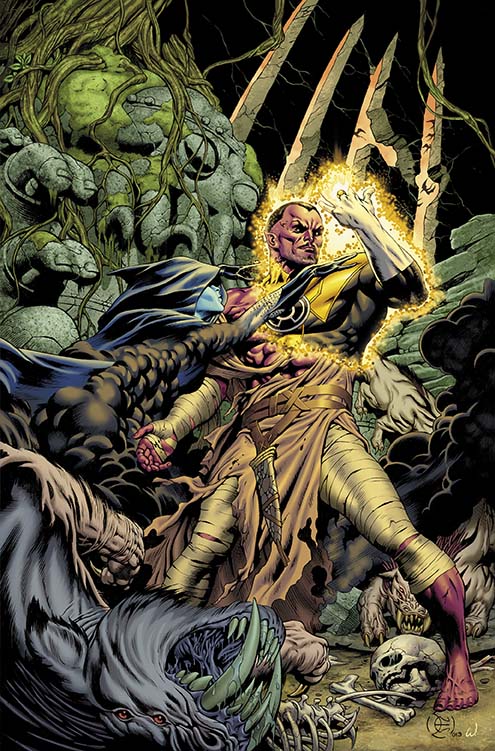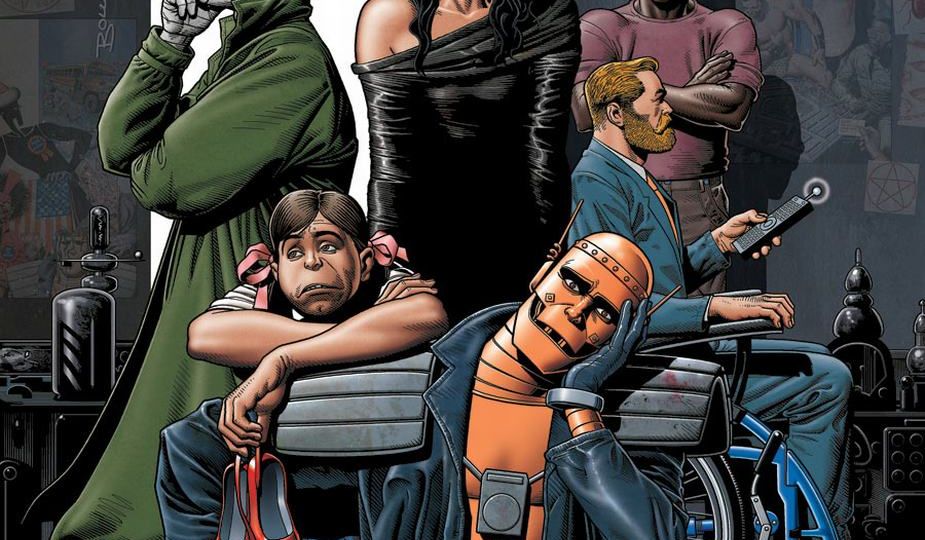
Doom Patrol by Grant Morrison, Richard Case, and others is one of Grant Morrison’s best comics in a career defined by writing truly incredible comics (see: Seaguy, The Invisibles, Allstar Superman). In Doom Patrol he took a low-profile book with reservoirs of untapped potential (something he and Warren Ellis are quite good at) and transformed it into a superhero Dadaist epic. Combining beautiful surrealism and strong character work, Morrison and Case created one of the masterpieces of the superhero genre. So here we are, and somehow I gotta narrow the list down to just nine wonderful things from this book. I hope you enjoy.
SUBSTANTIAL SPOILERS FOR DOOM PATROL, obviously.
1. Kicking God’s ass
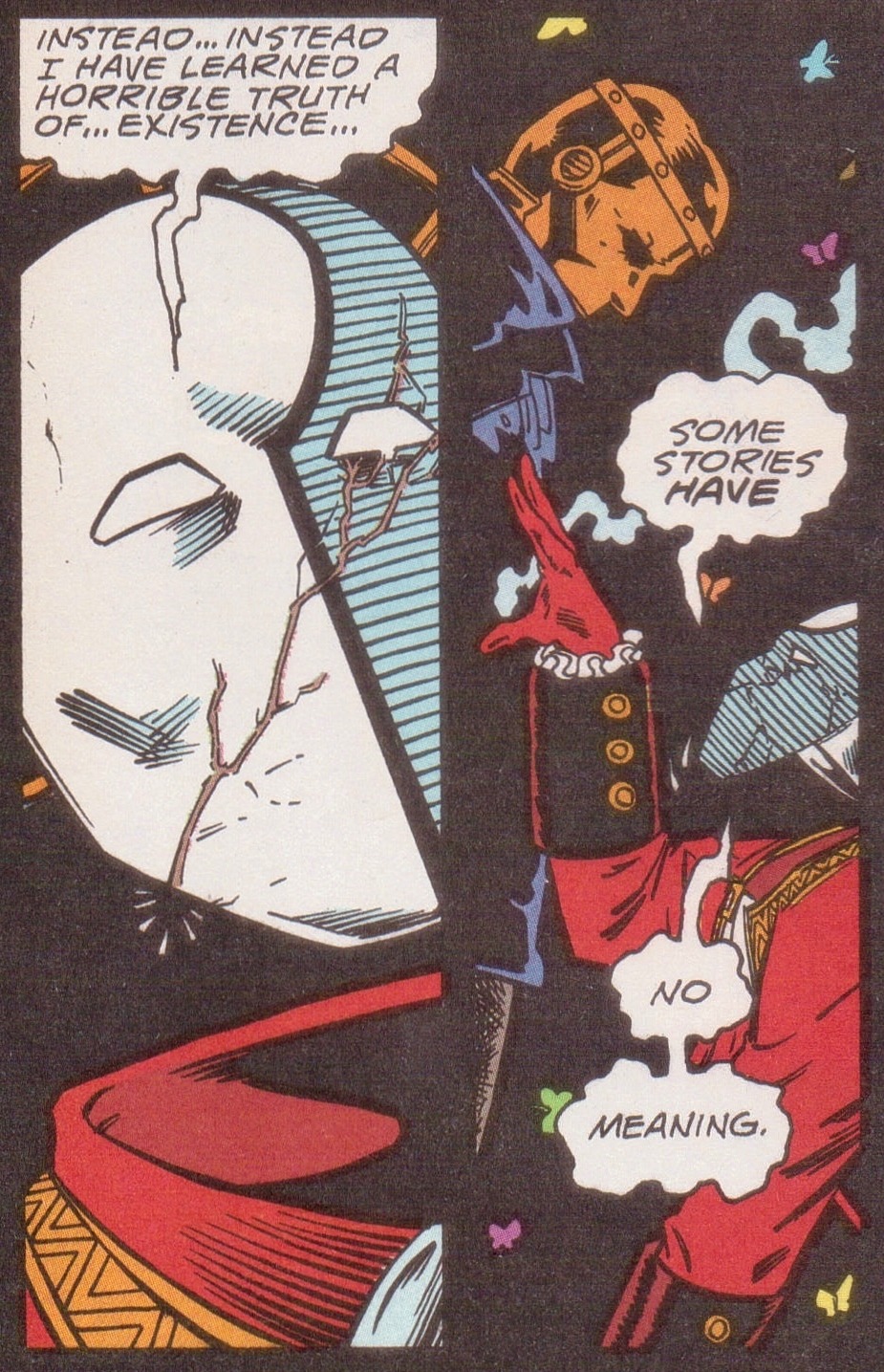
Long before Warren Ellis had The Authority kick God’s ass, Morrison introduced a one-time villain named Red Jack, who may or may not be both God and Jack the Ripper. He certainly believed himself to be. What we do know is that he’s a godlike being who gains strength from the suffering he inflicts when his self-imposed horror-mansion/prison intersects with our reality. Perhaps he was just a super-powered nutjob with an incredible sense of self-grandeur who feeds off suffering, or maybe he’s not what he says he is. Either way, Morrison crafted a captivating villain that provides the reader with food for thought. His character design and his large collection of still-alive pinned butterflies certainly didn’t hurt either. Morrison would create tons of brilliant villains for this series, including The Men from N.O.W.H.E.R.E. and The Candlemaker, but Red Jack stands out to me as one of the most fun and one of the most disturbing in implications.
2. The Brotherhood of Dada (eats Paris and awakens the Fifth Horseman)
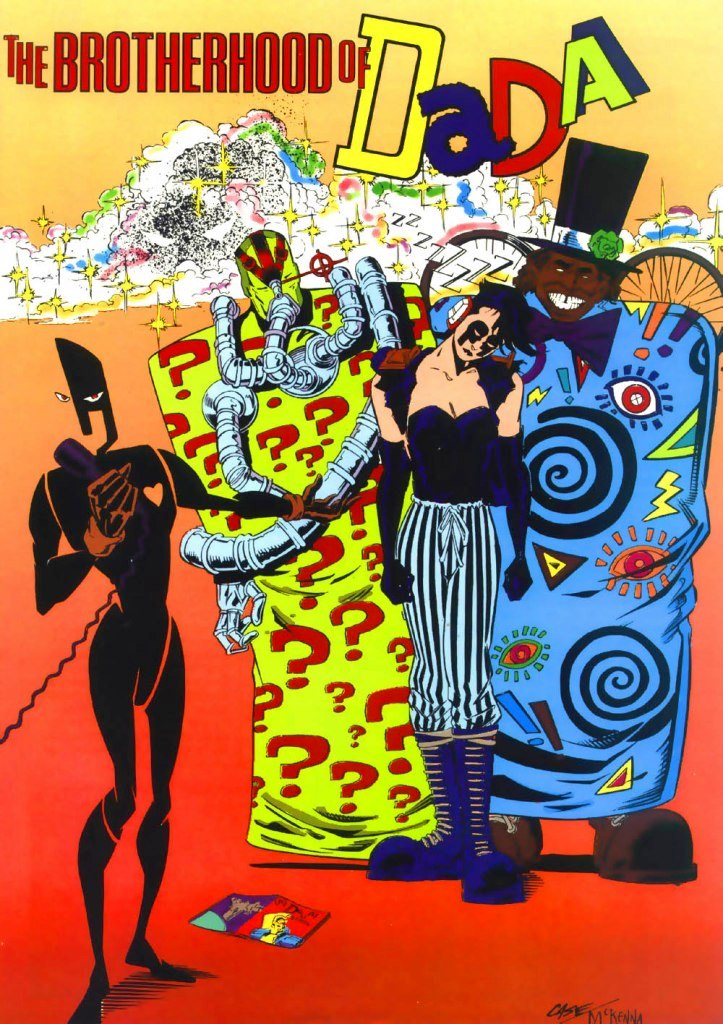
The Brotherhood of Dada is one of the very best things about Morrison’s run. It may be one of Morrison’s best ideas, and the man is a living idea-factory. Gone was the Brotherhood of Evil, replaced by the Brotherhood of Dada, a group formed purely to create surrealist anarchy. Their first mission was to have Paris eaten by a reality-devouring painting. In the process they kick the crap out of the Doom Patrol while also accidentally (almost) releasing the 5th Horseman of the Apocalypse, Oblivion, which was trapped in the painting. They’re a lovable bunch of chaos and whimsy that, especially as the series went on, not only challenged the idea of “villains”, but became a representative of what the Doom Patrol would be if they’d just let go and embrace the absurdity. They’re a substantial piece of Morrison’s grand thesis of the work, and they are highly entertaining and relatable while doing it.

3. Poem on the Underground Wall (Into the mind of Crazy Jane)

For a series full of truly stellar characters, Crazy Jane was always one of my favorites. Severe trauma from being sexually assaulted in her past forced her to fraction her psyche to better cope. She ended up splitting herself into 64 different personalities, and each personality had a superpower (or powers) to go along with it (I don’t remember how each gained powers). After stopping the 5th Horseman of the Apocalypse, ‘Main’ Jane becomes locked in her own mind. Cliff Steele (aka Robotman) goes into her brain to help her out of there. Guided by one personality of Jane, Cliff traverses the vast train station of her mind in search of the Jane personality he knows. This one-issue story is both eerie and captivating, presenting each personality in their own world, their own stop along the tracks of ‘Main’ Jane’s mind. It’s a great story, and our first peek into what makes Jane tick.
4. Monsieur Mallah and The Brain: A Love Story
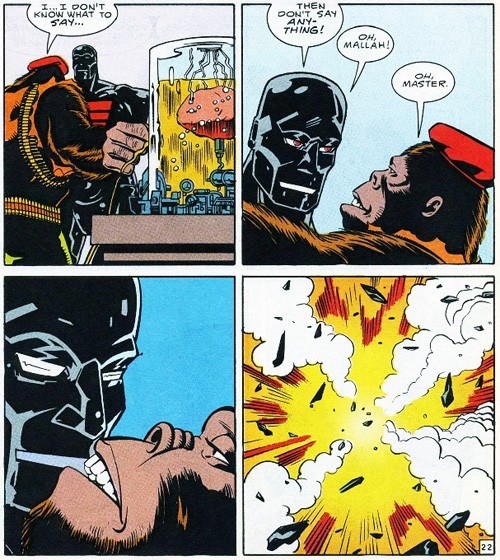
Remember that time Cliff lost his body, had a new one made for him, and then it got highjacked by The Brain? Remember then how Cliff’s brain was left alone in a jar, Monsieur Mallah and The Brain got together, and then the robot body’s defense protocols blew them both up? I do, and I find it hilarious every time. Grant Morrison’s proven himself to be funny when he wants to be, and this little moment was so unexpected yet made some kind bizarre sense that it just worked. Their declarations of love are a little sappy, and the whole exchange between them reads laughably (and purposefully) a little cliche, and that’s what makes it work so well. After blowing up, Cliff is left all alone in the glass tank, wearing Mallah’s beret, and Mallah’s chewing gum holding the cracked tank together. It’s such an absurd moment that it elicits a smile. I’m also happy to report that other writers who have written these two characters have kept the brain on gorilla romance alive.
5. Danny the Street

Danny the Street is a sentient, genderqueer city block that inserts themselves into random cities and towns, offering a sanctuary to the outcasts of society. Originally coined a “transvestite” (which is an outdated term that many trans people consider a transphobic slur now), Danny is a genderqueer individual whose stores are all stereotypically “masculine”, with a style and aesthetic that is stereotypically “feminine” (for example, a gun store with an abundance of lace and silk). Morrison’s attempt at a progressive character may be outdated and founded in some stereotypes, but, as a trans woman myself, I find his attempt to be inclusionary a noble (if ultimately flawed) one, and one ahead of its time in the “mainstream”. Or maybe I’m excusing Morrison’s problematic attempt because I fricking love Danny. I don’t know. It also helps that Danny’s just such a caring and loving person. Danny, like the Brotherhood of Dada, is another substantial piece to Morrison’s grand thesis in Doom Patrol. Towards the end of the run Danny becomes Danny the World, a whole new planet for the outcasted and strange. And Danny the World comes into play later.
6. Mr. Nobody for President!

What I neglected to mention earlier about the Brotherhood of Dada is that they make a very strong case for change–and a healthy dose of the bizarre–in our lives. Late in the series Mr. Nobody assembles a new Brotherhood of Dada, hooks up Albert Hoffman‘s bicycle to a schoolbus frame, and hits the campaign trail. Spreading psychedelic vibes to the people of America, Mr. Nobody’s platform centers on radical self-change and making life more Dada. Here Mr. Nobody steps even farther from his supervillain roots (he was originally a pre-Morrison Brotherhood of Evil member) to become somebody so groovy that I’d vote for him. He’s got some fair points, he isn’t full of shit, and dare I say he could actually make some change in this great American masquerade? Back on track now, this is one of the best storylines in all of Morrison’s run, partially because this is such a marked turning point. Except for Cliff, none of the Doom Patrol are remotely concerned about Mr. Nobody’s campaign, and one even reflects that he could be good for America. This is a substantial shift from traditional superhero narratives, which are driven primarily by slugfests or (sometimes) verbal and psychological conflicts with a villain. With no villain there’s no fight. All that’s left is the Doom Patrol and the Brotherhood of Dada finding much in common with one another, and Cliff struggling with the realization that if chaos can be good, and that the world is chaotic and sometimes better off for it. Sadly (and unsurprisingly), the US government is having none of this, and they assassinate Mr. Nobody during one of his campaign speeches.
7. Aegnigma Regis (The Becoming of Rebis)
Rebis is the trigender (male/female/agender) fusion of pilot Larry Trainor, physician Eleanor Poole, and the Negative Spirit. Rebis was left with jumbled collections of both Larry and Eleanor’s memories, and the fragmented understanding of a pure negative-energy being. Rebis left the Doom Patrol temporarily in a search to better understand themselves, and in issue 54, their search led them to the moon. There they stumble through hallucinogenic world-scenes that tend to involve sex (as a representation of joining) and apocalypse and death. A bandaged prostitute, falling meteors juxtaposed binary weather figurines, conjoined lovers trying to kill one another, apocalypse death theatre; it’s a heavily symbolic and surreal affair for a book (and an author) renowned (or reviled, depending on who you ask) for symbolism and surrealism. It plays like a grand, sometimes sexy nightmare intermingled with self-evolution. In the end Rebis comes to finally understand themselves, and is born anew…both literally and metaphorically. Earlier chapters revealed Rebis could have sex with themselves (actually have sex amongst itself, not masturbation), and here they give (re)birth to themselves on the moon. This is one of the more bizarre chapters in the whole series, and it’s one of the best ones in my opinion. Besides, who can resist the mysterious bandaged type in a fur coat.
Apparently someone uploaded the whole thing to read on imgur, if you’re so inclined.
8. You aren’t her father, Cliff
The relationship between Cliff Steele and Jane is the emotional crux of the narrative, and Morrison’s secondary but still substantial thesis of Doom Patrol. Since the beginning of the series, Cliff has taken a paternalistic father-figure role to Jane. While Cliff genuinely cares about Jane deeply, his interactions with Jane are restrictively paternalistic. He acts like a father trying to “fix” his daughter while being overprotective (and arguably condescendingly so). But as the series goes on, others point out to Cliff that his behavior, while well-intentioned, is kind of shitty, in its own way. Two very important things happen before the finale of the book: Cliff is forced to accept that Jane is her own woman and doesn’t need his male-shepherding; and that Jane reclaims her own agency, both from Cliff and his paternalism, and her scumbag rapist father. It is by her own will that she shapes her destiny, and Cliff comes to respect that. The ‘older male takes a younger woman under his wing and turns her into a daughter-figure to protect’ trope is flopped on its head and then buried deep within the earth. In the end, their relationship evolves substantially. Now they can meet on the same playing field as equals, with no weird old sexist behavior to prevent that.
9. The Finale (especially that final page)

And here we come to the best final page and the 2nd best series finale issues in comics (just behind Zero), amongst the likes of Scalped and Preacher (I will fight you until the day I die in defense of the solid gold Preacher finale). Anyway, here is the end of the road for the Doom Patrol, and the situation never looked bleaker. The “Hell” that The Candlemaker sent her in the last story arc of the series wasn’t the fire-and-brimstone Hell one typical associates with the word…it’s the mental healthcare system. A system that does not give a damn about her. A system that tries to convince her that all of her adventures with the Doom Patrol were imaginary, a way to cope with trauma. And the scary thing is, they could be right. Most of the chapter works to make us doubt the “reality” of Morrison’s entire narrative. It’s a heartbreaking affair, watching Jane’s world torn apart by callous doctors (save one), medication, electroshock therapy, and a bleak world that invalidates her at every turn. After extensive abuse, she’s released from the mental hospital. She tries to live a “normal” life, but how can she, after her various traumas and adventures? She leaves a note. “it’s not real.” She takes a suitcase to a bridge, and considers ending her life.
From there you can infer two main ideas from the ending. A much bleaker way to look at things is that she does commit suicide, and Cliff finding her and taking her to live on Danny the World is one last fantasy, or maybe a well-deserved Heaven. That the Doom Patrol and their adventures were all in her mind all along. It’s not the ending I believe, but it’s possible.
The ending I and most other people subscribe to is a much more bittersweet affair. Cliff really does find Jane, and they go to live together on Danny the World. I like to think that Jane found happiness. Found peace. Community. Love. I like to think Jane had the happiest ending she could, away from a world that did nothing but hurt her and treat her like garbage. She deserves it. Where it gets bitter is that the world we know is too ugly and too “normal” to allow those like Jane and Mr. Nobody to exist. All that there is for them in our world is violence, outcasting, loneliness. Danny the World–and our imaginations–are the only places people like Cliff and Jane and Rebis and Mr. Nobody can exist, free and unpersecuted. It’s a depressing thesis, one that there is a disturbing amount of validity to be found within.
In the words of The Smiths, quoted on the final page: “There is another world. There is a better world. Well…there must be.”















